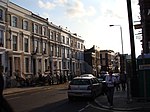Kensal House
1937 establishments in EnglandApartment buildings in LondonGrade II* listed buildings in the Royal Borough of Kensington and ChelseaLadbroke GroveModernist architecture in London ... and 2 more
Residential buildings completed in 1937Use British English from July 2020

Kensal House is a housing estate of two curved blocks of 68 housing association flats at the northern end of Ladbroke Grove, London, completed in 1937 and designed by the architect Maxwell Fry. It was the first modernist block in the UK designed to be occupied by the working class and on completion in 1937, was widely thought to be a prototype for modern living.
Excerpt from the Wikipedia article Kensal House (License: CC BY-SA 3.0, Authors, Images).Kensal House
Ladbroke Grove, London North Kensington (Royal Borough of Kensington and Chelsea)
Geographical coordinates (GPS) Address External links Nearby Places Show on map
Geographical coordinates (GPS)
| Latitude | Longitude |
|---|---|
| N 51.5253 ° | E -0.2151 ° |
Address
Kensal House
Ladbroke Grove
W10 5AD London, North Kensington (Royal Borough of Kensington and Chelsea)
England, United Kingdom
Open on Google Maps







